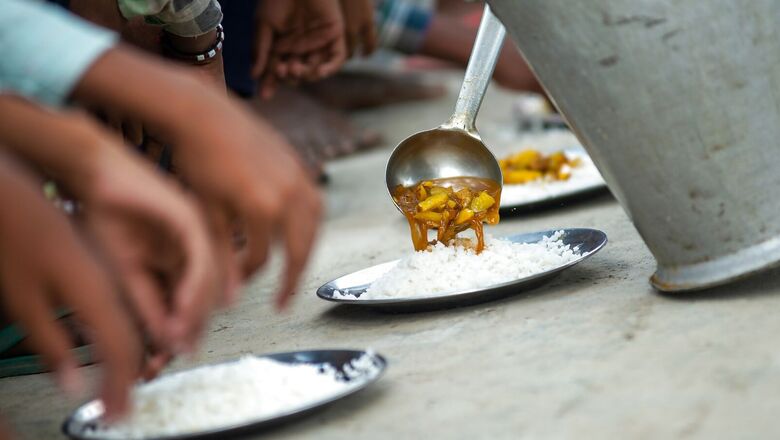
views
Addressing the nation during ‘Azadi Ka Amrit Mahotsav’ on Independence Day, Prime Minister Narendra Modi made an important announcement regarding the government’s priority to ensure that every person has access to nutrition. It was announced that the government will supply fortified rice to women and children under schemes like the Public Distribution System (PDS) and PM-POSHAN (formerly known as the Mid-Day Meal Scheme) by 2024.
The announcement came as the country was preparing to reinvigorate its efforts to tackle malnutrition by deploying scientific, evidence-based and innovative methods.
The Food Safety and Standards Authority of India’s (FSSAI’s) Food Fortification Resource Centre (FFRC) reported that over 70% of India’s population consumes less than half the daily recommended dietary allowance of micronutrients. These deficiencies are prevalent not only in women and children from rural areas but also affect population groups in urban India.
To address these issues, the Government of India has already put in place several measures like Anganwadis, the Pradhan Mantri Matru Vandana Yojana and the Scheme for Adolescent Girls under the umbrella Integrated Child Development Services (ICDS) Scheme.
Other social safety nets including the Public Distribution System, Antodaya Anna Rozgar Yojana, PM-POSHAN Scheme and the landmark 2013 Food Security Act are also collectively working towards India’s Zero Hunger goal. India’s free school lunch programme is one of the world’s largest anti-poverty measures.
Key to Addressing Nutrition Gap
Moreover, in a bid to directly address anaemia and micronutrient deficiency in the country, the Centre recently approved a pilot scheme on “Fortification of Rice & its Distribution under Public Distribution System”.
The government’s food fortification initiative is already taking shape with several states, including Andhra Pradesh, Gujarat, Maharashtra, Tamil Nadu, Chhattisgarh, Uttar Pradesh, Odisha, Telangana, Uttarakhand and Madhya Pradesh, starting the distribution of fortified rice under the pilot programme.
With a section of the populace having limited access to nutritious food, fortification is key in addressing the nutrition gap. Fortifying staple foods and condiments with key micronutrients is an effective way of addressing deficiencies. Timely adoption of food fortification in social and nutrition security programmes as a part of the fortification initiative will play a crucial role in addressing undernutrition in India.
Fortification is one of the most effective nutrition interventions in preventing nutritional deficiencies and contributing to India’s progress towards achieving UN Sustainable Development Goal (SDG) 2.2 of ‘ending all forms of malnutrition by 2030’.
Necessary Interventions
Additionally, according to the World Health Organisation (WHO), food fortification (including biofortification) and dietary diversification modify diet quality and diversity to address multiple micronutrient deficiencies and possibly help reduce the risk of diet-related health issues.
“Food-based nutrition interventions have a strong potential to enhance food security by improving food production and availability, processing, supply, and commercialisation, all while facilitating its access and consumption for improved nutrition outcomes,” the world health body has said.
In India, pilot projects led by the United Nations World Food Programme (WFP) on the integration of fortified rice in the PM-POSHAN have been carried out in several districts of Odisha between January 2013 and October 2018, and in Varanasi, Uttar Pradesh, from 2018 to 2020. The WFP has said that the project helped reduce anaemia among school children.
Why Rice?
Micronutrients such as iron are vital for the healthy development of children. Therefore, rice-fortification, as per WHO’s list of Evidence for Nutrition Actions (eLENA), is one of the most effective ways of addressing micronutrient malnutrition.
The Government of India has taken note of the high-level impact food fortification can have in fighting micronutrients malnutrition. Based on case studies complied in the FSSAI-FFRC compendium on fortification, consumption of fortified rice shows an increase in haemoglobin concentrations, plasma and vitamin B-12, and a decrease in homocysteine levels, iron deficiency and anaemia.
Under a pilot project through the PDS and school feeding programme, fortified rice is being provided to families and children in government and government-aided schools. If the supply is further increased, it could aid in fighting malnutrition and other deficiencies to a large extent.
Among other things, rice fortification involves manufacturing fortified rice kernels and blending them with the regularly consumed rice. But why focus on rice over flour? According to PATH, an organisation working on fortification in India since 2005, rice is more widely consumed across the country and therefore, extensive behaviour change is not necessary for rice fortification. In contrast, a more widespread shift would be required for flour fortification to work.
Since, most vulnerable people may already be those with limited access to industrially-milled flour, fortified rice, can be a game-changer in addressing child malnutrition.
Other food items issued by the FSSAI for mandatory fortification include wheat flour, maida, salt, refined edible vegetable oil and milk.
Impact So Far and Forward Motion
As per FSSAI-FFRC case studies, regular intake of fortified milk resulted in 18% lower incidence of diarrhea and 26% lower incidence of pneumonia, while the consumption of fortified edible oil depicted a significant 90% drop in cases of xerothalimia (abnormal dryness of the conjunctiva and cornea of the eye), and the continuous usage of fortified wheat flour showed decrease in anaemia levels.
The results are a testament that the decision to supply fortified rice to women and children through various schemes is an important step towards a malnutrition-free India.
However, to ensure complete nutritional security to everyone, a continued, healthy coordination between the Centre and state governments is necessary. Alongside capacity building in the public sector, the need of the hour is to implement best-in-class procurement and distribution models of fortified foods while managing economics and giving due importance to quality control.
Shridhar Venkat is CEO of Akshaya Patra Foundation. The views expressed in this article are those of the author and do not represent the stand of this publication.
Read all the Latest Opinions here




















Comments
0 comment